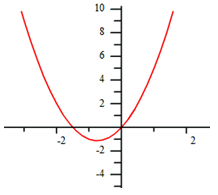Which Function Is It?
| Site: | Clare-Gladwin RESD |
| Course: | Michigan Algebra I |
| Book: | Which Function Is It? |
| Printed by: | Guest user |
| Date: | Saturday, 6 December 2025, 4:36 PM |
Description
Which Function Is It?
Linear or Quadratic
The first two units have been about linear and quadratic equations. This lesson will provide the tools to determine whether an equation, table or graph is a linear or a quadratic function.Linear and quadratic equations are the types of equations most commonly encountered in high school algebra and in real life applications. They are different from each other in a number of key ways.
Linear equations are usually in the form y = mx + b . Linear functions have a degree of one, which is the main factor in determining whether it is linear or quadratic. Quadratic equations are usually in the form y = ax 2 + bx + c . Quadratic functions have a degree of two, or a squared term; a linear function does not.
Examples
Example 1 Is 3x + 4 = 2y linear or quadratic?
Since the degree of the function is one, the equation is linear. In standard form the equation is 3x - 2y = -4.
Example 2 Is 4x - 3y = 2x2 linear or quadratic?
Since the degree of the function is two, the equation is quadratic. In standard form the equation is
.
Graphs
The graph of a linear equation is a straight line. This line can be diagonal, horizontal or vertical. A quadratic equation results in a U - shaped graph called a parabola. These shapes are easily identifiable and also represented by these function families.Example Is the graph below linear or quadratic?

The graph is a quadratic function because it is a U-shaped graph.
Solutions
When given a y value, a linear equation will result in only one solution for an x value. A quadratic equation can have two solutions for x when given a y value. This is also true of the graph's x -intercepts. A linear function can have at most one x -intercept and a quadratic can have at most two x -intercepts.Tables
The table of a linear function will have a common first difference, while the table of a quadratic will have a common second difference.Example 1 Does the table below represent a linear or a quadratic function?
![]()

Step 2. If the first difference is constant, the function is linear. If not, find the second difference.
The first difference is constant, so the function is linear.
The equation of the function is y = 2x + 9.
Example 2
Does the table below represent a linear or a quadratic function?
Step 1. Find the first difference.

Since the first difference is not constant, find the second difference.

Step 3. If the second difference is constant, the function is quadratic. If not, label the function as other.
This table has a common second difference, so it is quadratic.
The function that models this table is ![]() .
.
Interactive Activities
To match linear and quadratic graphs with equations, select the following link:Linear or Quadratic - Graphs
To match linear and quadratic equations with tables, select the following link:
Linear or Quadratic - Tables
Practice
Linear or Quadratic WorksheetAnswer Key
Linear or Quadratic Answer KeySources
EHow, "Differences Between Quadratic & Linear Equations." http://www.ehow.com/facts_5483849_differences-between-quadratic-linear-equations.html (accessed 8/9/2010).
Embracing Mathematics, Assessment & Technology in High Schools; A Michigan Mathematics & Science Partnership Grant Project
GeoGebra.org, "Writing Equations to Match Tables." http://www.geogebra.org/en/upload/files/english/steve_phelps/CP_Geometry/Equations_from_Tables.html (accessed 8/9/2010).
University of Vienna, "The Big Picture Puzzle." http://www.univie.ac.at/future.media/moe/tests/fun1/erkennen.html (accessed 07/27/2010).